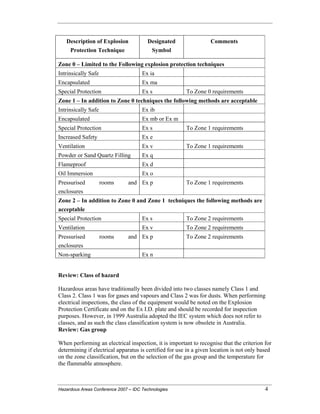Roar Solutions for Dummies
Table of ContentsSome Known Details About Roar Solutions The 10-Minute Rule for Roar SolutionsExamine This Report about Roar Solutions
In such an environment a fire or surge is feasible when 3 basic conditions are fulfilled. This is typically described as the "unsafe area" or "burning" triangular. In order to protect installations from a potential explosion a technique of analysing and classifying a possibly harmful area is required. The objective of this is to ensure the correct selection and installment of equipment to ultimately protect against an explosion and to ensure safety and security of life.

No equipment ought to be set up where the surface temperature level of the tools is greater than the ignition temperature level of the given threat. Below are some typical dust dangerous and their minimum ignition temperature. Coal Dirt 380C 225C Polythene 420C (thaws) Methyl Cellulose 420C 320C Starch 460C 435C Flour 490C 340C Sugar 490C 460C Grain Dust 510C 300C Phenolic Material 530C > 450C Aluminium 590C > 450C PVC 700C > 450C Residue 810C 570C The likelihood of the threat existing in a concentration high adequate to trigger an ignition will certainly differ from area to area.
In order to identify this risk a setup is divided right into areas of risk relying on the quantity of time the harmful is present. These areas are described as Areas. For gases and vapours and dirts and fibres there are 3 zones. Zone 0 Area 20 A harmful atmosphere is extremely likely to be present and might exist for long durations of time (> 1000 hours each year) or perhaps continuously Area 1 Area 21 A harmful environment is possible yet not likely to be present for extended periods of time (> 10 450 C [842 F] A category of T6 indicates the minimal ignition temperature level is > 85 C [185 F] Unsafe location electric devices perhaps created for use in higher ambient temperature levels. This would certainly suggested on the score plate e.g. EExe II C T3 Ta + 60C( This indicates at 60C ambient T3 will certainly not be gone beyond) T1 T1, T2, T3, T4, T5, T6 T2 T2, T3, T4, T5, T6 T3 T3, T4, T5, T6 T4 T4, T5, T6 T5 T5, T6 T6 T6 A T Course score of T1 indicates the optimum surface temperature level produced by the tool at 40 C is 450 C. Presuming the associated T Course and Temperature ranking for the devices are proper for the location, you can always utilize a tool with a more rigorous Division score than needed for the area. There isn't a clear response to this concern. It truly does depend on the sort of tools and what repair work require to be accomplished. Tools with particular examination treatments that can't be carried out in the field in order to achieve/maintain third celebration rating. Must return to the manufacturing facility if it is prior to the devices's solution. Area Repair By Authorised Worker: Difficult testing may not be called for however particular treatments might require to be followed in order for the equipment to preserve its 3rd party rating. Authorised workers have to be used to execute the work correctly Repair work need to be a like for like substitute. New part should be considered as a straight substitute requiring no special testing of the equipment after the repair service is full. Each tool with an unsafe rating ought to be assessed separately. These are detailed at a high degree below, however, for more comprehensive details, please refer straight to the standards.
Not known Details About Roar Solutions
The equipment register is a thorough data source of equipment records that consists of a minimum collection of fields to recognize each product's place, technological criteria, Ex classification, age, and environmental information. This info is crucial for tracking and managing the devices successfully within hazardous areas. On the other hand, for routine or RBI sampling evaluations, the quality will certainly be a combination of Comprehensive and Close evaluations. The proportion of Comprehensive to Shut evaluations will certainly be figured out by the Tools Risk, which is examined based upon ignition risk (the likelihood of a source of ignition versus the possibility of a combustible atmosphere )and the harmful area classification
( Area 0, 1, or 2). This variation will also affect the resourcing needs for job preparation. Once Great deals are specified, you can establish sampling strategies based upon the sample dimension of each Great deal, which describes the variety of random tools products to be examined. To determine the required sample size, 2 aspects need to be evaluated: the size of the Lot and the category of examination, which indicates the level of effort that should be applied( decreased, normal, or raised )to the examination of the Whole lot. By combining the group of examination with the Lot size, you can after that develop the proper rejection requirements for a sample, suggesting the allowable variety of damaged products discovered within that sample. For more information on this procedure, please describe the Energy Institute Guidelines. The IEC 60079 typical suggests that the optimum period between evaluations should not exceed 3 years. EEHA inspections will additionally be performed beyond RBI campaigns as component of arranged maintenance and tools overhauls or fixings. These examinations can be attributed toward the RBI sample sizes within the influenced Whole lots. EEHA evaluations are performed to recognize faults in electric devices. A weighted racking up system is crucial, as a solitary item of tools might have several mistakes, each with varying degrees of ignition risk. If the mixed score of both examinations is less than twice the mistake score, the Whole lot is considered appropriate. If the Lot is still taken into consideration unacceptable, it needs to go through a complete assessment or justification, which may cause stricter examination protocols. Accepted Whole lot: The root causes of any kind of faults are identified. If a typical failure setting is discovered, added equipment may call for maintenance. Mistakes are classified by extent( Security, Integrity, Home cleaning ), making sure that immediate issues are analyzed and addressed immediately to mitigate any kind of impact on safety and security or operations. The EEHA data source should track and tape the lifecycle of faults together with the rehabilitative activities taken. Carrying out a robust Risk-Based Assessment( RBI )strategy is critical for ensuring compliance and security in taking care of Electric Devices in Hazardous Locations( EEHA) (electrical refresher course). Automated Mistake Scoring and Lifecycle Administration: Easily manage helpful hints mistakes and track their lifecycle to boost inspection accuracy. The intro of this assistance for risk-based examination additionally reinforces Inspectivity's setting as a best-in-class solution for regulatory compliance, along with for any kind of asset-centric examination usage instance. If you want finding out much more, we invite you to request a demo and uncover just how our service can transform your EEHA monitoring procedures.
More About Roar Solutions

In regards to explosive threat, a harmful area is an environment in which an eruptive ambience exists (or may be anticipated to be existing) in amounts that need special precautions for the construction, setup and usage of tools. hazardous area electrical course. In this write-up we explore the obstacles faced in the workplace, the danger control procedures, and the called for expertises to work securely
It issues of modern life that we make, store or manage a variety of gases or liquids that are considered flammable, and a variety of dirts that are deemed flammable. These compounds can, in specific problems, create explosive environments and these can have significant and unfortunate consequences. The majority of us are acquainted with the fire triangle get rid of any among the 3 elements and the fire can not take place, but what does this mean in the context of harmful areas? When breaking this down right into its easiest terms it is essentially: a mix of a certain quantity of launch or leakage of a certain substance or material, blending with ambient oxygen, and the existence of a resource of ignition.
In the majority of instances, we can do little regarding the levels of oxygen in the air, but we can have significant influence on resources of ignition, for instance electric tools. Hazardous areas are documented on the harmful area category drawing and are identified on-site by the triangular "EX-SPOUSE" indication. Below, among various other key information, areas are divided right into 3 types relying on the danger, the chance and duration that an explosive ambience will certainly exist; Zone 0 or 20 is deemed the most dangerous and Zone 2 or 22 is deemed the least.
Comments on “Unknown Facts About Roar Solutions”